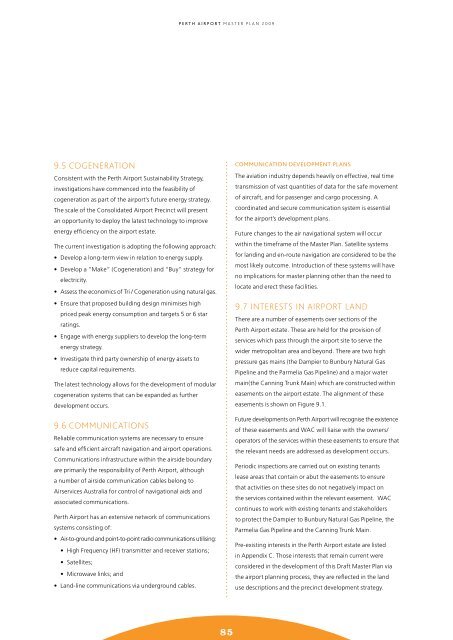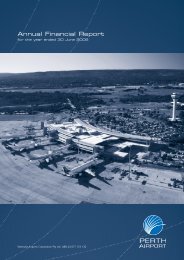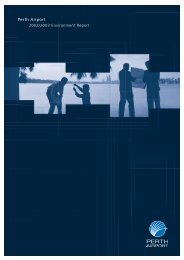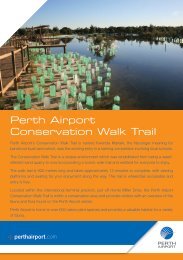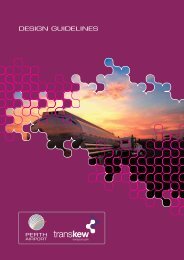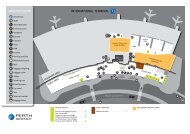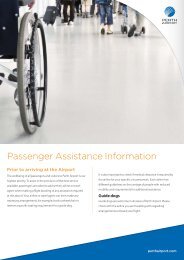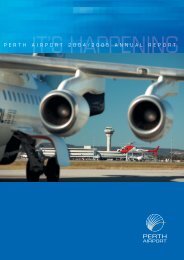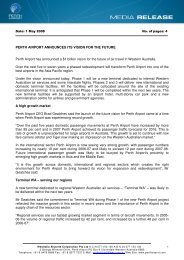PERTH AIRPORT Master Plan 2009
PERTH AIRPORT Master Plan 2009
PERTH AIRPORT Master Plan 2009
You also want an ePaper? Increase the reach of your titles
YUMPU automatically turns print PDFs into web optimized ePapers that Google loves.
P E R T H A I R P O R T M a s t e r P l a n 2 0 0 9<br />
9.5 Cogeneration<br />
Consistent with the Perth Airport Sustainability Strategy,<br />
investigations have commenced into the feasibility of<br />
cogeneration as part of the airport’s future energy strategy.<br />
The scale of the Consolidated Airport Precinct will present<br />
an opportunity to deploy the latest technology to improve<br />
energy efficiency on the airport estate.<br />
The current investigation is adopting the following approach:<br />
• Develop a long-term view in relation to energy supply.<br />
• Develop a “Make” (Cogeneration) and “Buy” strategy for<br />
electricity.<br />
• Assess the economics of Tri / Cogeneration using natural gas.<br />
• Ensure that proposed building design minimises high<br />
priced peak energy consumption and targets 5 or 6 star<br />
ratings.<br />
• Engage with energy suppliers to develop the long-term<br />
energy strategy.<br />
• Investigate third party ownership of energy assets to<br />
reduce capital requirements.<br />
The latest technology allows for the development of modular<br />
cogeneration systems that can be expanded as further<br />
development occurs.<br />
9.6 Communications<br />
Reliable communication systems are necessary to ensure<br />
safe and efficient aircraft navigation and airport operations.<br />
Communications infrastructure within the airside boundary<br />
are primarily the responsibility of Perth Airport, although<br />
a number of airside communication cables belong to<br />
Airservices Australia for control of navigational aids and<br />
associated communications.<br />
Perth Airport has an extensive network of communications<br />
systems consisting of:<br />
• Air-to-ground and point-to-point radio communications utilising:<br />
• High Frequency (HF) transmitter and receiver stations;<br />
• Satellites;<br />
• Microwave links; and<br />
• Land-line communications via underground cables.<br />
Communication Development <strong>Plan</strong>s<br />
The aviation industry depends heavily on effective, real time<br />
transmission of vast quantities of data for the safe movement<br />
of aircraft, and for passenger and cargo processing. A<br />
coordinated and secure communication system is essential<br />
for the airport’s development plans.<br />
Future changes to the air navigational system will occur<br />
within the timeframe of the <strong>Master</strong> <strong>Plan</strong>. Satellite systems<br />
for landing and en-route navigation are considered to be the<br />
most likely outcome. Introduction of these systems will have<br />
no implications for master planning other than the need to<br />
locate and erect these facilities.<br />
9.7 Interests In Airport Land<br />
There are a number of easements over sections of the<br />
Perth Airport estate. These are held for the provision of<br />
services which pass through the airport site to serve the<br />
wider metropolitan area and beyond. There are two high<br />
pressure gas mains (the Dampier to Bunbury Natural Gas<br />
Pipeline and the Parmelia Gas Pipeline) and a major water<br />
main(the Canning Trunk Main) which are constructed within<br />
easements on the airport estate. The alignment of these<br />
easements is shown on Figure 9.1.<br />
Future developments on Perth Airport will recognise the existence<br />
of these easements and WAC will liaise with the owners/<br />
operators of the services within these easements to ensure that<br />
the relevant needs are addressed as development occurs.<br />
Periodic inspections are carried out on existing tenants<br />
lease areas that contain or abut the easements to ensure<br />
that activities on these sites do not negatively impact on<br />
the services contained within the relevant easement. WAC<br />
continues to work with existing tenants and stakeholders<br />
to protect the Dampier to Bunbury Natural Gas Pipeline, the<br />
Parmelia Gas Pipeline and the Canning Trunk Main.<br />
Pre-existing interests in the Perth Airport estate are listed<br />
in Appendix C. Those interests that remain current were<br />
considered in the development of this Draft <strong>Master</strong> <strong>Plan</strong> via<br />
the airport planning process, they are reflected in the land<br />
use descriptions and the precinct development strategy.<br />
85


